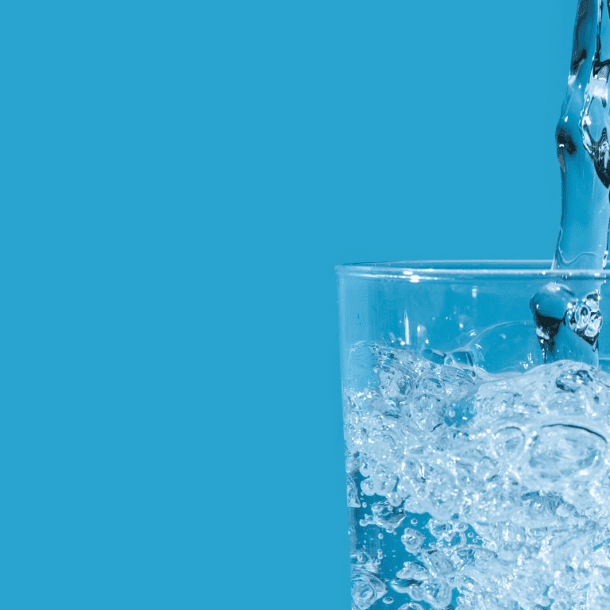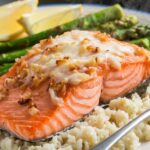
Please note: This website contains affiliate links. As an Amazon Associate, we earn from qualifying purchases at no additional cost to you.
Are you hooked on sugar?
Unfortunately you’re not alone! Most Americans eat way too much sugar, with an average of 17 teaspoons daily. This is almost double what’s recommended. It adds up to about 60 pounds of sugar per person each year.
Yes, 60 POUNDS of sugar.
Clearly, sugar addiction is a big problem….. but there’s hope! You can break free from sugar’s hold and improve your health. We’ll look at the latest research on sugar and its dangers. We’ll also give you a plan to cut down on sugar and make lasting changes in your diet.
Get ready to take back control of your sugar addiction. Enjoy a healthier, more balanced life.
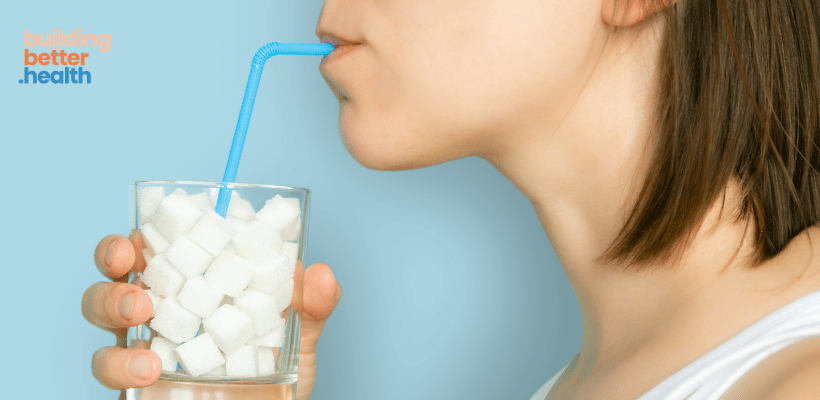
The Sugar Crisis: Understanding America’s Overconsumption
America is in the middle of a sugar crisis. Studies reveal that 60% of Americans eat too much sugar. On average, they consume up to 92 grams of added sugar each day. This is way over the limits set by health experts.
Current Sugar Consumption Statistics
The numbers are alarming. Between 2011 and 2014, 63% of kids and 49% of adults drank sugary drinks every day. These drinks added 143 and 145 calories to their diets, respectively. The Northeast and South have the highest rates of sugary drink consumption, with 68% and 67% of adults drinking them daily.
Health Impacts of Excessive Sugar Intake
Too much sugar is bad for our health. It leads to obesity, with 35% of men and 40.4% of women aged 20-74 being obese in 2014. It also causes type 2 diabetes, heart disease, cancer, and tooth decay. This highlights the need to tackle America’s sugar problem.
Added Sugar vs. Natural Sugar Differences
It’s key to know the difference between added sugars and natural sugars. Natural sugars are found in whole foods and are processed slower. Added sugars, however, are absorbed quickly, causing blood sugar spikes. Understanding this helps us make better food choices and fight sugar addiction.
Hidden Sources of Sugar in Common Foods
Many people know about obvious sugar sources like desserts and sweet drinks. But, they might not know about hidden sugars in everyday foods. Cutting down on sugar intake and eating mindfully can greatly improve your healthy eating habits.
Ketchup is a surprising source of hidden sugar. Just one tablespoon has a teaspoon (5 grams) of sugar, making up 29% of its total content. Low-fat foods also often have more sugar than their full-fat versions. For example, a 6-ounce serving of low-fat vanilla yogurt has 24 grams of sugar, while full-fat plain yogurt has only 8 grams.
- Canned fruits and vegetables can be high in added sugars, so it’s important to read the labels.
- Breakfast cereals, granola, and even some smoothies can contain significant amounts of sugar, often in the form of syrups or fruit juices.
- Fruit juices, although they may seem healthy, can also be laden with added sugars, sometimes containing as much as a soda.
| Food Item | Sugar Content |
|---|---|
| Ketchup (1 tbsp) | 5 grams |
| Low-fat vanilla yogurt (6 oz) | 24 grams |
| Full-fat plain yogurt (6 oz) | 8 grams |
| Canned mandarin oranges in light syrup (1 cup) | 39 grams |
| Fast-food coleslaw (1 regular side) | 15 grams |
| Lemon-flavored iced tea (1 bottle) | 32 grams |
Knowing about these hidden sugar sources and checking nutrition labels can help you make better choices. This way, you can reduce your sugar intake and stick to healthy eating habits. Practicing mindful eating can also help you notice your sugar intake and make lasting changes to your diet.
The Science Behind Sugar Addiction and Cravings
Sugar addiction is real and can harm your health. The science shows why it’s hard to stop eating sugar. Let’s explore how sugar addiction works and how to beat it.
How Sugar Affects Brain Chemistry
Sugar makes dopamine, a key brain chemical, release. This makes us feel good, like an addictive drug. But, our brains get used to it and want more to feel that way again.
Understanding Sugar’s Impact on Hormones
Sugar messes with our hunger hormones. Eating too much sugar can make us eat more and gain weight. This messes up our hunger signals and makes us crave more sugar.
Why Sugar Creates Dependency
Sugar quickly goes into our blood, causing big changes in blood sugar. This makes us feel stressed and want more sugar to feel better. It’s a cycle that’s hard to break.
“Sugar is eight times more addictive than cocaine.” – Dr. Nicole Avena, neuroscientist and expert on food addiction
To beat sugar addiction, we need to understand it and take steps to stop. By tackling the reasons behind sugar cravings, we can control our sugar intake and get healthier.
How to Stop Eating Sugar: Practical Steps
Reducing sugar intake is a tough but rewarding journey to better health. It’s all about taking practical steps to quit sugar, reduce sugar intake, and adopt healthy eating habits. Let’s look at some effective ways to do a sugar detox.
- Ditch Sugary Drinks: Sugary drinks, like soda and fruit juices, are the biggest source of added sugars in the American diet. Choose water, unsweetened tea, or infused water instead.
- Avoid Processed Sweets: Stay away from sugary desserts, candies, and processed snacks. Instead, enjoy fresh fruits or a small piece of dark chocolate.
- Choose Full-Fat Foods: When you can, pick full-fat foods over low-fat or non-fat options. They usually have less added sugar.
- Cook from Scratch: Make meals with whole, unprocessed ingredients. This way, you avoid hidden sugars in many packaged foods.
- Be Cautious with “Healthy” Snacks: Even snacks called “healthy” can have a lot of sugar. Always check the nutrition labels.
Lowering sugar intake is a journey that needs time and dedication. But the health benefits are worth it. By following these steps, you’re on your way to a healthier, sugar-free life.
| Beverage Alternatives | Healthy Snack Options | Natural Sweetener Substitutes |
|---|---|---|
| Water, unsweetened tea, infused water | Fresh fruit, nuts, Greek yogurt, vegetable sticks with hummus | Honey, maple syrup, stevia, dates, cinnamon, vanilla extract |
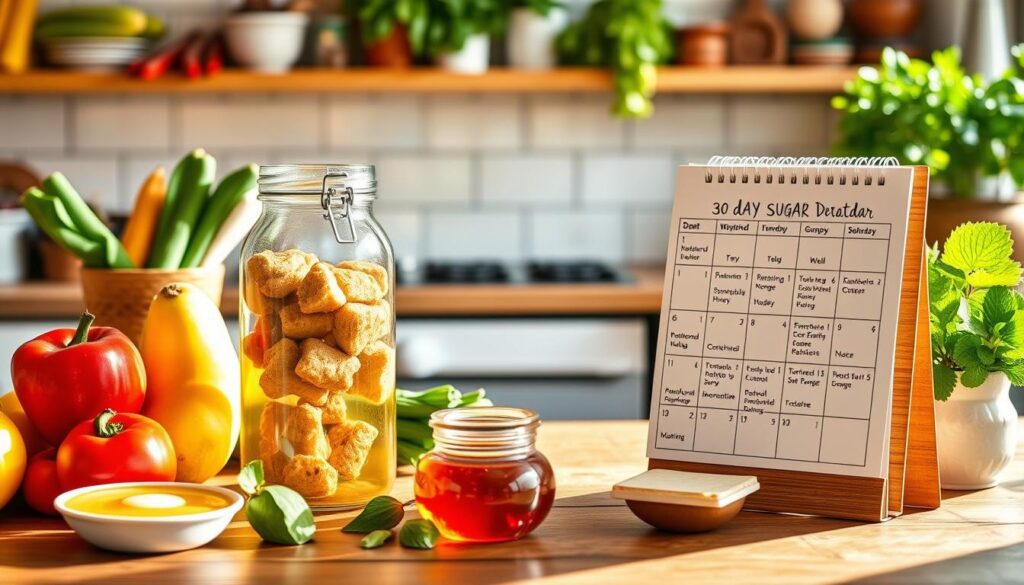
Smart Sugar Swaps for Common Foods
Reducing sugar intake doesn’t mean you have to miss out. Simple swaps in your daily diet can help lower sugar and promote health. Explore smart substitutions for drinks, snacks, and natural sweeteners.
Beverage Alternatives
Replace sugary drinks like soda, juice, and sweet coffee with better choices. Opt for water, unsweetened sparkling water, herbal teas, or black coffee. These drinks are sugar-free, helping you stay hydrated without the sugar rush.
Healthy Snack Options
- Choose fresh fruit, nuts, or Greek yogurt with cinnamon instead of candy or cookies.
- Go for homemade trail mix with nuts and seeds instead of sugary granola bars.
- Indulge in a small piece of dark chocolate (at least 70% cacao) for a sweet treat.
Natural Sweetener Substitutes
Use natural sweeteners like honey, maple syrup, or stevia when recipes call for sugar. They offer sweetness without the metabolic issues of refined sugar. Just remember, natural sweeteners are potent, so use them sparingly.
By making these simple changes, you can cut down on sugar and move towards a healthier diet. Try different alternatives to find what works best for you.
Reading Food Labels: Identifying Hidden Sugars
Reading food labels is key in the fight against too much sugar. Now, food makers must list added sugars on labels. This helps health-focused shoppers make better choices.
When checking ingredients, look for sugar names like high fructose corn syrup and honey. The closer these are to the top of the list, the more sugar the item has. Even natural-sounding options like maple syrup are still added sugars and should be used sparingly.
Also, check the Nutrition Facts panel. New labels make it clear what’s added sugar and what’s not. The Percent Daily Value (%DV) helps you see how much sugar a food has. Aim for no more than 25 to 36 grams of sugar daily.
Learning to read labels well is a big step towards eating healthier and cutting sugar. Use this knowledge to make choices that are good for your body and long-term health.
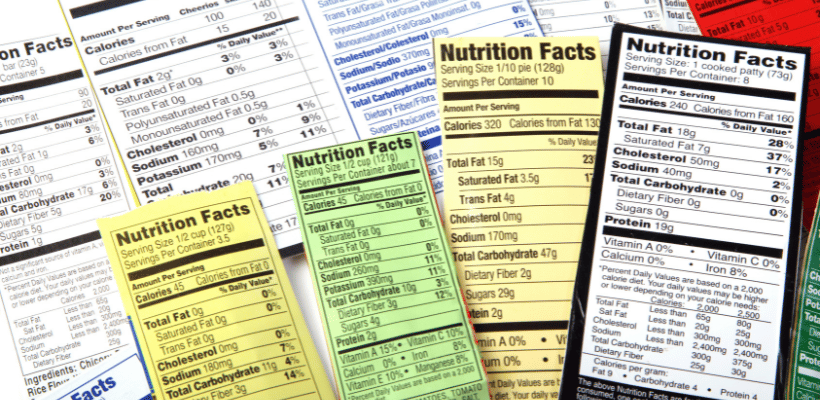
“The first step towards mindful eating is understanding what’s in your food. Reading labels empowers you to make informed choices that align with your health goals.”
The Role of Protein and Fat in Reducing Sugar Cravings
Trying to break sugar cravings? Focus on protein and fat-rich foods. A diet high in protein and fiber can reduce hunger and make you feel full.
High-Protein Foods That Help
Adding just 25% more protein can cut cravings by 60%. Choose protein-rich foods like meat, fish, eggs, and full-fat dairy. Avocados and nuts are also good choices. They help keep your blood sugar stable and make you feel full longer.
Healthy Fats for Satiety
Healthy fats are also key in fighting sugar cravings. Avocados, nuts, seeds, and olive oil make you feel full and satisfied. Adding these fats to your diet can help you stick to a low-sugar diet.
By eating a balanced diet with plenty of protein, fiber, and healthy fats, you can fight sugar cravings. This effort can help you control your sugar intake and enjoy a healthier lifestyle.
In Conclusion
By choosing whole foods over refined sugars, you’ll stop sugar cravings.
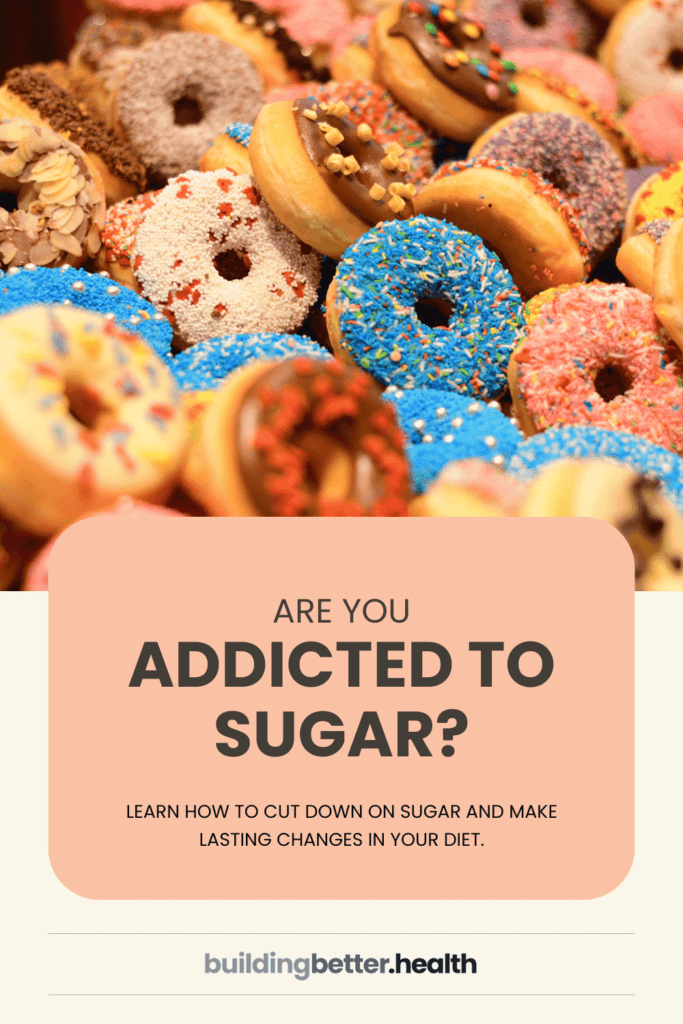
Please note: This website contains affiliate links. As an Amazon Associate, we earn from qualifying purchases at no additional cost to you.


